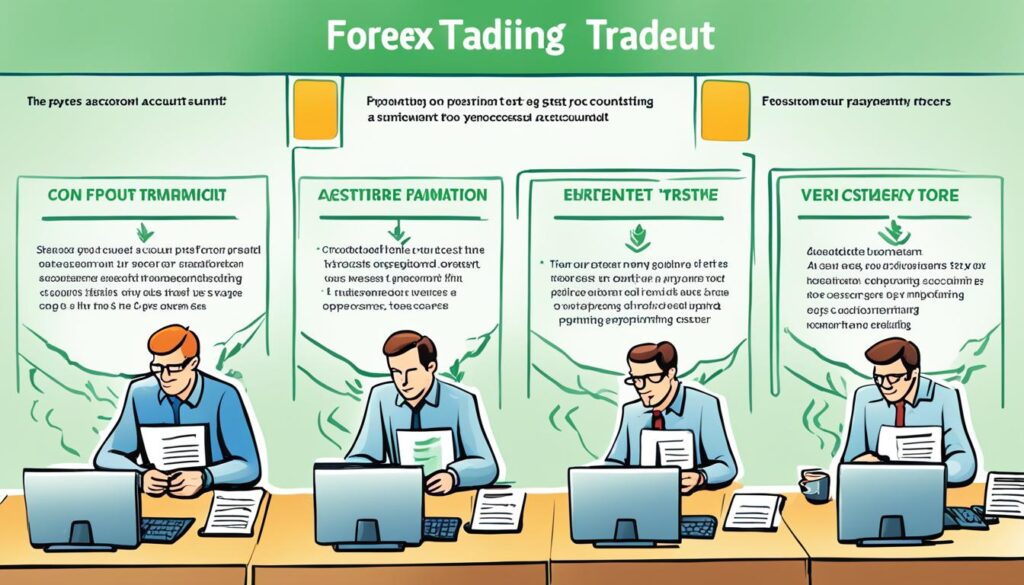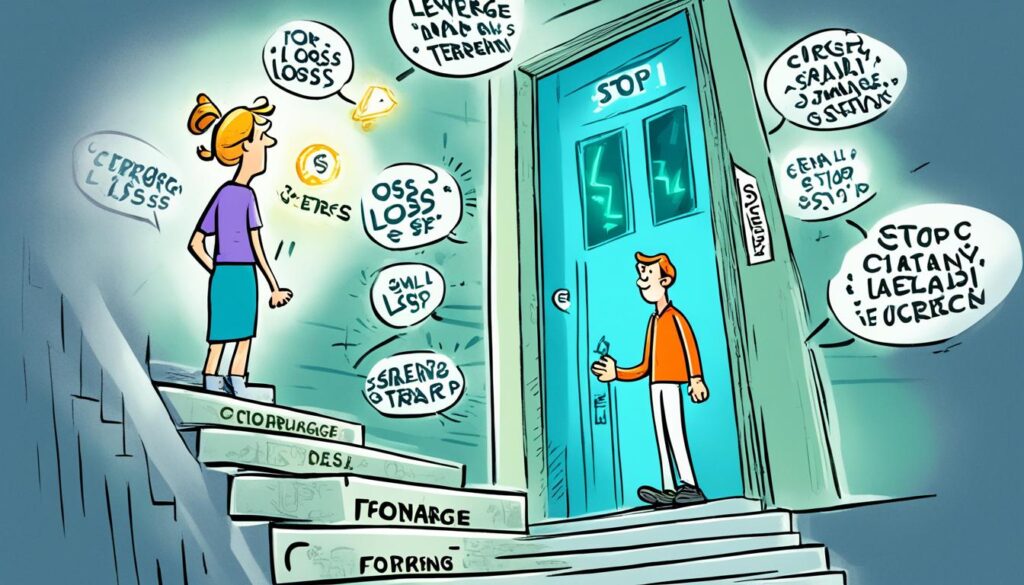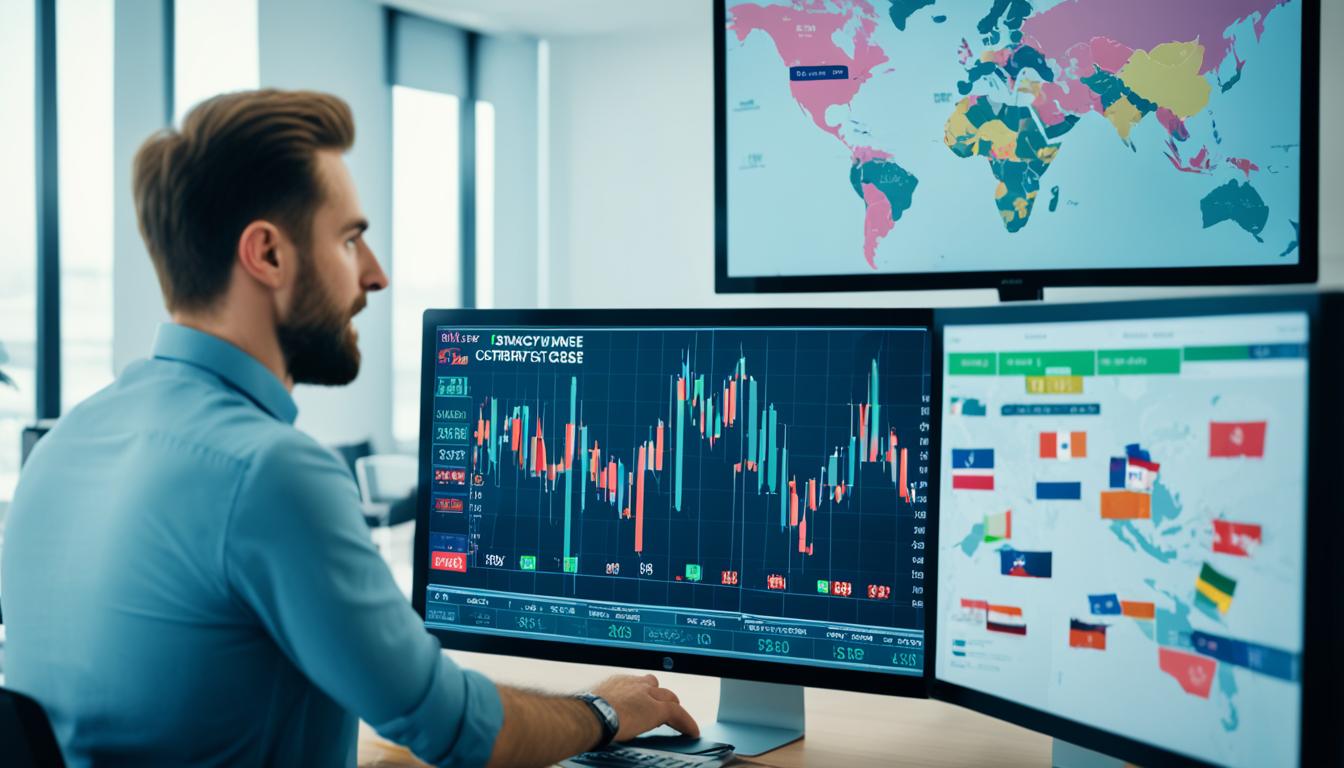Forex Trading for Beginners Step by Step Guide
Did you know the Forex market trades over $6 trillion every day? That’s more than any other financial market! It’s no surprise many want to start trading currencies. This guide helps beginners start their journey in Forex trading step by step or dip their toes in.
We’ll explain the basics of Forex trading, help you pick the right platform, and teach you analysis methods. By the end, you’ll know how to navigate the Forex market confidently and use effective trading strategies.
Key Takeaways
- Over $6 trillion is traded daily in the Forex market.
- This guide will help you start your currency trading journey.
- Learn essential Forex terminology and market mechanics.
- Understand the importance of choosing the right broker.
- Discover key technical and fundamental analysis tools.
- Gain insights into managing risks and maintaining a trading mindset.
Understanding Forex Trading Basics
To start, let’s look at what Forex trading is all about. First, we’ll cover the currency trading basics. Then, we’ll introduce key terms and explain how the market works.
What is Forex Trading?
Forex trading is the act of swapping one currency for another on the Forex market. It’s the world’s biggest financial market, with trades totaling over $6 trillion each day. This market helps out everyone from individuals to governments by supporting global trade and investment.
Key Terms You Need to Know
For successful Forex trading, it’s important to recognize several key terms:
- Currency Pairs: Shows how two different currencies are valued against each other (like EUR/USD).
- Pips: This is the smallest price movement in the market, usually meaning 0.0001.
- Spreads: It’s the gap between the cost to buy and sell a currency pair.
- Leverage: Allows you to magnify potential gains with borrowed funds.
- Margin: The money you need to put down to use leverage.
How the Forex Market Works
The Forex market is not tied to one place or entity, so it’s considered decentralized. This means trading happens directly between traders, usually through banks, brokers, and financial institutions. It’s also open 24/5, giving traders the chance to act on global economic news at any time.
Central banks are big players in the Forex market:
| Institution | Role |
|---|---|
| Federal Reserve (USA) | It sets policies to keep the U.S. economy strong and stable. |
| European Central Bank (ECB) | This bank oversees the euro and aims to stabilize prices in Europe. |
| Bank of Japan (BOJ) | It works on keeping Japan’s currency stable and its economy growing. |
Learning these currency trading basics and practicing Forex market analysis will help you make smarter trading decisions.
How to Get Started with Forex Trading
Starting Forex trading means making sure you’re ready and know what you’re doing. You should pick a good Forex broker, set up your trading account, and learn about leverage and margin. This will help you start off well.
Choosing the Right Broker
Choosing the right Forex broker is crucial. You should make sure they’re regulated by top financial authorities. Look for brokers like TPT Forex that provide great service and competitive features. Also, check out their credibility, reviews, and tools like TPT CopyTrading for a better trading experience.
Setting Up Your Trading Account
After you pick a broker, you need to set up your trading account. Brokers will ask for basic info to follow regulations, like proof of who you are and some financial details. Pick an account that fits your trading style, such as standard, mini, or demo. You also need to add some money to your accout and get to know your broker’s trading platform.

Understanding Leverage and Margin
Understanding leverage and margin is key in Forex trading. Leverage helps you control a big trade with a small amount of money. But it can make your wins or losses bigger. Margin is like a deposit needed for a leveraged trade. It’s important to really understand these to avoid big losses and manage risk well. Always start with low leverage to get the hang of things.
By getting these first steps down, you’ll feel more ready to step into Forex trading with confidence and care.
Forex Trading Platforms
Choosing the right forex platform is key for success. You must know what each platform offers. This helps it fit your trading style.
Popular Trading Platforms
Many forex platforms work for different styles. Some top names include MetaTrader 4, MetaTrader 5, and TradingView. They have strong charting tools, tech analysis, and are easy to use. This makes smart trading decisions easier.
TPT Forex and TPT CopyTrading
TPT Forex platform is known for its cool features and easy design. The TPT CopyTrading feature lets you copy trades from pros. It helps new traders learn from the best.
Platform Features to Consider
When looking at platforms, check these features:
- User Interface: A clean, easy interface helps with trading.
- Charting Tools: Advanced tools and indicators aid in market analysis.
- Order Types: Make sure it supports various order types.
- Execution Speed: Quick trade speeds help you act on market opportunities.
- Customer Support: Strong support solves problems fast for smooth trading.
- Security: It must keep your info safe with strong security measures.
With lots of options, pick one that fits you best. The TPT Forex platform and its TPT CopyTrading feature give extra benefits. This is especially good for new forex traders.
Technical Analysis Indicators
Technical analysis indicators help Forex traders understand market trends. They include moving averages, the Relative Strength Index (RSI), and Bollinger Bands. These tools are essential for making smart decisions.
Moving Averages
Moving averages turn price data into a smooth line for trend spotting. The Simple Moving Average (SMA) and Exponential Moving Average (EMA) are types. They show if a trend might change direction, giving traders key information.

Relative Strength Index (RSI)
The RSI measures price movement speed and change. It helps spot when prices are too high or too low on a scale of 0 to 100. An RSI above 70 means a currency might be too high. Below 30 suggests it might be too low.
Bollinger Bands
Bollinger Bands use a middle moving average and two volatility-based outer bands. They change shape with market volatility. Price nearing the upper band shows a possible overbuying. Near the lower band, it might be oversold, pointing to potential reversals.
Using these indicators well can significantly improve your trading. They’re important for predicting market movements accurately.
Fundamental Analysis Factors
It’s key for traders to know what moves the Forex market. Fundamental analysis involves studying economic data, political news, and market feelings. This helps predict how currencies will move. With this info, traders can improve their strategies.
Economic Indicators
Economic data is big in fundamental Forex analysis. Numbers like GDP growth, job figures, and interest rates affect currency prices. If the U.S.’s GDP goes up, the USD might get stronger. Big events like job data changes or rate decisions from the Federal Reserve can move currencies a lot.
Political Events
Politics is a big player in Forex too. Elections, new policies, and world tensions can shake up markets. Platforms such as the US, UK, and China can create big waves. Take Brexit; it firmly shook the British Pound. Knowing about these events helps predict market moves, aiding in your plan.
Market Sentiment
Market sentiment is basically how people feel about a currency or the market. It checks the general vibe, whether positive (bullish) or negative (bearish). Websites like TPT Forex and TPT CopyTrading provide tools to study this. By understanding sentiment, you can craft a strategy based on the market’s mood.
Knowing about economic, political, and market views is crucial. It forms a solid approach to Forex analysis. This approach guides you in making smart trading choices. Thus, improving your chances in the Forex market.
Risk Management Strategies
In the ever-volatile world of Forex trading, it’s vital to use strong risk management. This protects your investments. Good risk management can lead to long-term success. It helps avoid short-term losses. Now, let’s look at some important techniques.
Setting Stop Losses
Stop-loss orders are key in managing risk. They let you set a maximum loss for each trade. This way, you can limit how much you might lose. Setting stop losses at smart levels protects your capital from big drops. This helps you follow your trading plan easily.

Diversification
Using diversification, you spread your investments. This lowers the risk because you don’t rely on one investment. Instead, if you lose in one place, you might gain in another. It applies not just in Forex trading but also in other types of investing. Platforms like TPT Forex and TPT CopyTrading are useful for diversifying well.
Position Sizing
Position sizing plays a big role in risk management. It means figuring out how much to trade based on your whole portfolio. By doing this, you handle risk better. It includes looking at your risk tolerance and the current market setup. The right position size means you’re not putting too much at risk in a single trade. This lets you trade more sustainably.
| Key Techniques | Benefits |
|---|---|
| Stop-Loss Orders | Limits potential losses, ensuring capital protection |
| Diversification | Reduces risk by spreading investments across different assets |
| Position Sizing | Manages risk exposure, promotes sustainable trading practices |
Trading Psychology
Every Forex trader must understand trading psychology. This means knowing how to control your emotions and stick to your plan. Winning and losing in trades can bring up strong feelings. But, it’s crucial not to let these feelings guide your choices. Controlling your emotions can save you from big financial losses. It helps you think clearly, even when the market is up and down.
Emotional control is at the heart of good trading. Feelings like fear and greed can make you act without thinking, messing up your strategy. By keeping your emotions in check, you can follow your plan no matter what the market does. Having a disciplined approach means you set clear goals, have a strong plan, and stick to it.
Having a set routine can help you trade more smartly. Here’s a basic routine that works:
- Look at the market and its updates every day.
- Tweak your trading plan when needed.
- Have goals that are possible and check how you are doing often.
Following these steps will make you better at controlling your thoughts and actions while trading.
“Successful traders know that having a strong mental edge can be just as important as having the best trading strategy.”
Using platforms like TPT Forex and TPT CopyTrading can also make trading easier. They have tools that can improve your trading psychology. This leads to more controlled and consistent trading.
Here’s how the two platforms compare:
| Platform | Features | Benefits |
|---|---|---|
| TPT Forex | Advanced analytics, real-time updates | Improves decision-making, maintains emotional control |
| TPT CopyTrading | Automated trading, community insights | Encourages disciplined trading, less emotional trading |
By using tools and platforms for your trading psychology, you can do better in the Forex market.
Forex Trading for Beginners Step by Step
Starting forex trading needs a good plan to win. Here, we’ll go through the key steps to help you. This will set a solid base for *learning about trading* step by step.

Start with learning the basics of forex trading. This means getting to know terms like pips, spreads, and leverage. Knowing these will help you see how the forex market works.
Pick the best trading platform for you. TPT Forex and TPT CopyTrading are good for new traders. Look at your options to match your trading aims.
Understanding technical and fundamental analysis next. Use things like Moving Averages and RSI to guess where prices will move. Combine this with looking at economic clues and news to make better projections.
Making a risk plan is key to avoid big losses. Set stop losses on your trades, spread your investments, and think carefully about the size of your deals.
Also, your mindset while trading is super important. Stay cool, avoid snap decisions, and keep learning. This will make you better over time.
- Understand Basic Terms: pips, spreads, leverage.
- Choose a Trading Platform: Consider TPT Forex and TPT CopyTrading.
- Learn Technical and Fundamental Analysis: Moving Averages, RSI, Bollinger Bands, and economic indicators.
- Implement Risk Management: Set stop losses, diversify, and manage trade sizes.
- Focus on Trading Psychology: Stay disciplined and learn continuously.
Here’s a *quick reminder* of the key steps. They’re all about having a smart plan to *grow your trading understanding*:
| Step | Action | Outcome |
|---|---|---|
| 1 | Understand Basic Terms | Foundational Knowledge |
| 2 | Choose a Trading Platform | Ease of Trading |
| 3 | Learn Analysis Techniques | Informed Decisions |
| 4 | Implement Risk Management | Minimized Losses |
| 5 | Focus on Trading Psychology | Emotional Control |
Following these steps can change you from a beginner to a skilled forex trader. You’ll have strong strategies and knowledge for success.
Money Management Techniques
Being good at managing your money is key in successful Forex trading. These skills help you keep check on your trades and aim for long-term gains. We will talk about keeping a trading journal, understanding risk versus reward, and being flexible in your strategy to do well in the market.
Maintaining a Trading Journal
One top money management tip is to keep a trading journal. This means writing down each trade. It helps you see what you’re doing right and what could be better. The benefits are clear: you can track your progress, spot mistakes, and fine-tune your plans. By looking back at your journal often, you can avoid making the same mistakes twice.
Calculating Risk-to-Reward Ratio
Figuring out the risk-to-reward ratio is essential. It tells you if a trade is worthwhile by weighing the chances of profit against loss. A good ratio keeps your trading balanced and cuts down on risks.
- Identify potential entry and exit points.
- Estimate possible profit and loss for each trade.
- Divide the potential profit by the possible loss to get the risk-to-reward ratio.
Adapting Your Strategy
Being able to change your game is crucial in Forex. You must always evaluate the market and fine-tune your tactics. Stay adaptable and your trading strategies will be sharp and in line with the market, improving your success rate.
| Money Management Technique | Benefit | Implementation |
|---|---|---|
| Maintaining a Trading Journal | Keeps track of performance and identifies areas for improvement. | Document every trade, review regularly. |
| Calculating Risk-to-Reward Ratio | Helps determine the viability of trades by comparing potential profit and loss. | Estimate profit and loss, then calculate ratio. |
| Strategy Adaptation | Ensures trading plans are aligned with current market conditions. | Regularly assess and adjust strategies as needed. |
Conclusion
Starting your currency trading journey is an important step. It teaches you that becoming good takes time and effort. This guide has shown you the basics of forex trading – from how the market works to the best platforms like TPT Forex and TPT CopyTrading. By using this info, you can make smart choices that might bring success.
When trading, being good at managing risks is key. It involves setting stop losses, having a mix of investments, and choosing the right sizes for your deals. This protects your money against the market’s ups and downs. It’s also important to keep a trading journal and know your risk-to-reward ratio. These methods help you get better at trading and improve your plan.
As you keep trading, remember to keep learning and adjusting. The forex market is always changing. Being aware of news about the economy, politics, and what others think about the market helps you stay ahead. With the tips from this guide, you’re ready to face the challenges and do well in your trading.
